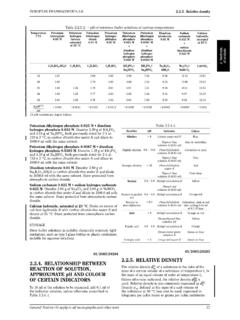Transcription of European Pharmacopoeia, Fourth Edition (2002) 2. Methods ...
1 European pharmacopoeia , Fourth Edition (2002), 2. Methods of analysis - abstracts. Page 1 European pharmacopoeia , Fourth Edition (2002) 2. Methods of analysis. POTENTIOMETRIC DETERMINATION OF PH The pH is a nu mber, which represents conventionally the hydrogen ion concentration of an aqueous solution. For practical purposes, its definition is an experimental one. The pH of a solution to be examined is related to that of a reference solution (pHS) by the following equation: pH = pHs - (E-ES)/k in which E is the potential, expressed in volts, of the cell containing the solution to be examined and E is the potential, expressed in volts, of the cell containing the solution of known pH (pHS) Table - Values of k at different temperatures Temperature C k 15 20 25 30 35 The potentiometric determination of pH is made by measuring the potential difference between 2 appropriate electrodes immersed in the solution to be examined.
2 One of these electrodes is sensitive to hydrogen ions (usually a glass electrode) and the other is the reference electrode (for example, a saturated calomel electrode). Apparatus. The measuring apparatus is a voltmeter with an input resistance at least 100 times that of the electrodes used. It is normally graduated in pH units and has a sensitivity such that discrimination of at least pH unit or at least V may be achieved. Method. Unless otherwise prescribed in the monograph, all measurements are made at the same temperature (20 C to 25 C). Table shows the variation of pH with respect to temperature of a number of reference buffer solutions used for calibration.
3 For the temperature correction when necessary, follow the manufacturer's instructions. The apparatus is calibrated with the buffer solution of potassium hydrogen phthalate (primary standard) and one other buffer solution of different pH (preferably one shown in Table ). The pH of a third buffer solution of intermediate pH read off on the scale must not differ by more than pH unit from the value corresponding to this solution. Immerse the electrodes in the solution to be examined and take t he reading in the same conditions as for the buffer solutions . When the apparatus is in frequent use, checks must be carried out regularly.
4 If not, su ch checks should be carried out before each measurement. All solutions to be examined and the reference buffer solutions must be prepared using carbon dioxide-free water R. PREPARATION OF REFERENCE BUFFER solutions potassium tetraoxalate M. Dissolve g of C4H3KO8, 2H2O in carbon dioxide-free water R, and dilute to ml with the same solvent. Saturated potassium hydrogen tartrate at 25 C. Shake an excess of C4H5KO6 vigorously with carbon dioxide-free water R at 25 C. Filter or decant Prepare immediately before use. potassium dihydrogen citrate M.
5 Dissolve g of C6H7KO7 in carbon dioxide-free water R and dilute to ml with the same solvent Prepare immediately before use. potassium hydrogen phthalate M. Dissolve g of CgHsKO4, dried at 110 C to 135 C, in carbon dioxide-free water R and dilute to ml with the same solvent potassium dihydrogen phosphate M + disodium hydrogen phosphate M. Dissolve g of KH2PO4 and g of Na2 HPO 4, both dried for 2 h at 110 C to 130 C, in carbon dioxide-free water R and dilute to ml with the same solvent. potassium dihydrogen phosphate M + disodium hydrogen phosphate M.
6 Dissolve g of KH2PO4 and g of Na2 HPO4, both dried for 2 hat 110 C to 130 or, in carbon dioxide-free water R and dilute to ml with the same solvent. Disodium tetraborate M. Dissolve g of Na2B4O7, 10H2O in carbon dioxide-free water R and dilute to ml with the same solvent. Store protected from carbon dioxide atmosphere. Sodium carbonate M + sodium hydrogen carbonate M. Dissolve g of Na2CO3 and g of NaHCO3 in carbon dioxide-free water R and dilute to ml with the same solvent. European pharmacopoeia , Fourth Edition (2002), 2. Methods of analysis - abstracts.
7 Page 2 Table - pH of reference buffer solutions at various temperatures Temperature C potassium tetraoxalate M potassium hydrogen tartrate (Sat. 25 C) potassium dihydrogen citrate M potassium hydrogen phthalate M potassium dihydrogen phosphate M + disodium hydrogen phosphate M potassium dihydrogen phosphate M + disodium hydrogen phosphate M Disodium tetraborate M Sodium carbonate M + sodium bicarbonate M C4H3KO8, 2H2O C4H5KO6 C6H7KO7 C8H5KO4 KH2PO4+ Na2 HPO4 KH2PO4+ Na2 HPO4 Na2B4O7, 10 H2O Na2CO3+ NaHCO3 15 20 25 30 35 pH(1)/ t + + (1) pH variation per degree Celsius.
8 Page 24-25 LOSS ON DRYING Loss on drying is the loss of mass expressed as per cent m/m. Method. Place the prescribed quantity of the substance to be examined in a weighing bottle previously dried under the conditions prescribed for the substance to be examined. Dry the substance to constant mass or for the prescribed time by one of the following procedures. a) "in a desiccator": the drying is carried out over diphosphorus pentoxide R at atmospheric pressure and at room temperature; b) "in vacuo": the drying is carried out over diphosphorus pentoxide R, at a pressure of kPa to kPa at room temperature; c) "in vacuo within a specified temperature range": the drying is carried out over diphosphorus pentoxide R, at a pressure of kPa to kPa within the temperature range prescribed in the monograph.
9 D) "in an oven within a specified temperature range": the drying is carried out in an oven within the temperature range prescribed in the monograph; e) "under high vacuum": the drying is carried out over diphosphorus pentoxide R at a pressure not exceeding kPa, at the t emperature prescribed in the monograph. If other conditions are prescribed, the procedure to be used is described in full in the monograph. Page 48 IRON Dissolve the prescribed quantity of the substance to be examined in water R and dilute to 10 ml with the same solvent or use 10 ml of the prescribed solution.
10 Add 2 m a 200 g/l solution of citric acid Rand ml of thioglyc acid R. Mix, ma ke alkaline with ammonia R and dilute t 20 ml with water R. Prepare a standard in the same man using 10 ml of iron standard solution (1 ppm Fe) R. After 5 min, any pink colour in the test solution is not m intense than that in the standard. SULPHATED ASH Ignite a platinum, porcelain or quartz crucible at 600 +/-50 C for 30 min, allow to cool in a desiccator over silica gel and weigh. Place the prescribed amount of the substance to be examined in the crucible and weigh. Moisten the substance to be exa mined with a small amount of sulphuric acid R (usually 1 ml) and heat gently at as Iowa temperature as practicable until the sample is thoroughly charred.




